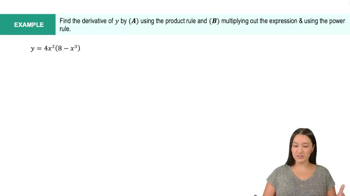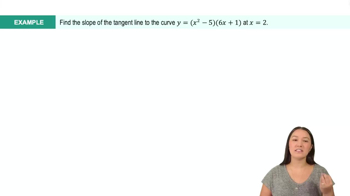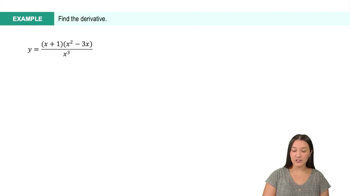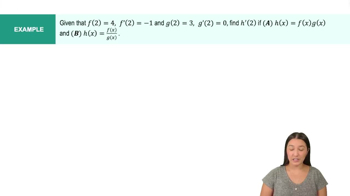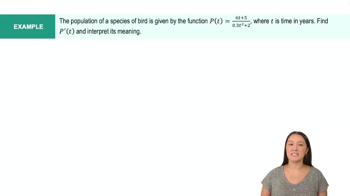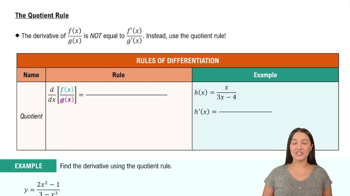Table of contents
- 0. Functions7h 52m
- Introduction to Functions16m
- Piecewise Functions10m
- Properties of Functions9m
- Common Functions1h 8m
- Transformations5m
- Combining Functions27m
- Exponent rules32m
- Exponential Functions28m
- Logarithmic Functions24m
- Properties of Logarithms34m
- Exponential & Logarithmic Equations35m
- Introduction to Trigonometric Functions38m
- Graphs of Trigonometric Functions44m
- Trigonometric Identities47m
- Inverse Trigonometric Functions48m
- 1. Limits and Continuity2h 2m
- 2. Intro to Derivatives1h 33m
- 3. Techniques of Differentiation3h 18m
- 4. Applications of Derivatives2h 38m
- 5. Graphical Applications of Derivatives6h 2m
- 6. Derivatives of Inverse, Exponential, & Logarithmic Functions2h 37m
- 7. Antiderivatives & Indefinite Integrals1h 26m
- 8. Definite Integrals4h 44m
- 9. Graphical Applications of Integrals2h 27m
- 10. Physics Applications of Integrals 2h 22m
3. Techniques of Differentiation
Product and Quotient Rules
Problem 31
Textbook Question
Find and simplify the derivative of the following functions.
h(x) = (x − 1)(x3+ x2 + x+1)
 Verified step by step guidance
Verified step by step guidance1
Step 1: Identify the function h(x) = (x - 1)(x^3 + x^2 + x + 1). This is a product of two functions, so we will use the product rule to find the derivative.
Step 2: Recall the product rule for derivatives: if u(x) and v(x) are functions, then the derivative of their product is given by (uv)' = u'v + uv'.
Step 3: Let u(x) = x - 1 and v(x) = x^3 + x^2 + x + 1. First, find the derivative of u(x), which is u'(x) = 1.
Step 4: Next, find the derivative of v(x). Differentiate each term separately: v'(x) = 3x^2 + 2x + 1.
Step 5: Apply the product rule: h'(x) = u'(x)v(x) + u(x)v'(x). Substitute the derivatives and original functions: h'(x) = (1)(x^3 + x^2 + x + 1) + (x - 1)(3x^2 + 2x + 1). Simplify the expression to find the derivative.
 Verified video answer for a similar problem:
Verified video answer for a similar problem:This video solution was recommended by our tutors as helpful for the problem above
Video duration:
4mPlay a video:
Was this helpful?
Key Concepts
Here are the essential concepts you must grasp in order to answer the question correctly.
Derivative
The derivative of a function measures how the function's output value changes as its input value changes. It is defined as the limit of the average rate of change of the function over an interval as the interval approaches zero. The derivative is a fundamental concept in calculus, representing the slope of the tangent line to the curve of the function at any given point.
Recommended video:

Derivatives
Product Rule
The product rule is a formula used to find the derivative of the product of two functions. It states that if you have two functions, u(x) and v(x), the derivative of their product is given by u'v + uv'. This rule is essential when differentiating functions that are expressed as products, such as the function h(x) in the question.
Recommended video:
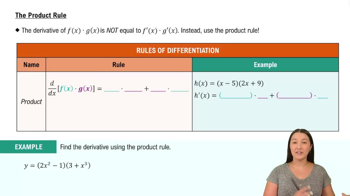
The Product Rule
Simplification of Derivatives
After finding the derivative of a function, simplification is often necessary to express the result in a more manageable form. This may involve combining like terms, factoring, or reducing fractions. Simplifying the derivative helps in understanding the behavior of the function, such as identifying critical points and analyzing concavity.
Recommended video:

Derivatives
Related Videos
Related Practice



